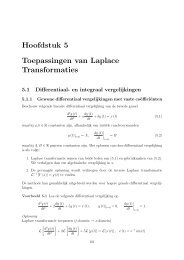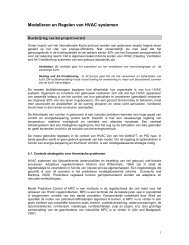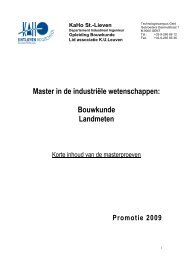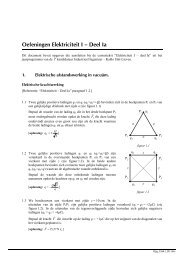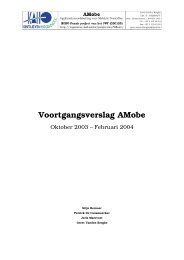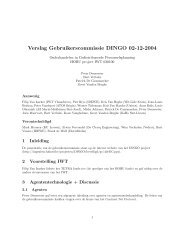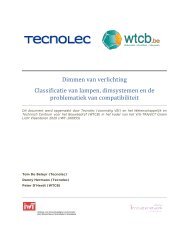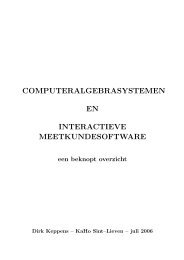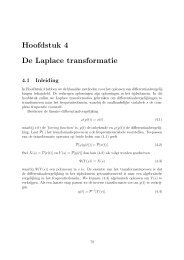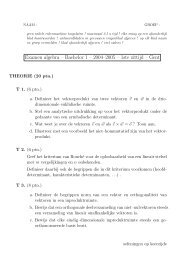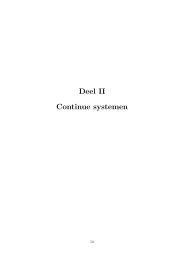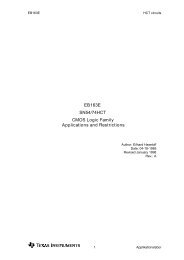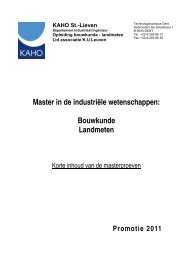Evaluation of Employee Rosters with the Extended Linear ...
Evaluation of Employee Rosters with the Extended Linear ...
Evaluation of Employee Rosters with the Extended Linear ...
You also want an ePaper? Increase the reach of your titles
YUMPU automatically turns print PDFs into web optimized ePapers that Google loves.
<strong>Evaluation</strong> <strong>of</strong> <strong>Employee</strong> <strong>Rosters</strong> <strong>with</strong> <strong>the</strong><br />
<strong>Extended</strong> <strong>Linear</strong> Numberings Method<br />
Patrick De Causmaecker 1 , Peter Demeester 2 , Greet Vanden Berghe 2 and Bart Verbeke 2<br />
1 Katholieke Universiteit Leuven Campus Kortrijk<br />
Computer Science and Information Technology<br />
Etienne Sabbelaan 53, 8500 Kortrijk, Belgium<br />
Email: Patrick.DeCausmaecker@kuleuven-kortrijk.be<br />
2 KaHo Sint-Lieven, Departement Industrieel Ingenieur<br />
Information Technology<br />
Gebroeders Desmetstraat 1, 9000 Gent, Belgium<br />
Email: {peter.demeester, greet.vandenberghe, bart.verbeke}@kahosl.be<br />
Abstract<br />
In this paper we introduce <strong>the</strong> extended linear numberings<br />
method for evaluating <strong>the</strong> quality <strong>of</strong> employees’ rosters.<br />
The extension to <strong>the</strong> original linear numberings method was<br />
necessary to cover a wider range <strong>of</strong> constraints from various<br />
employee rostering problems. We created an XML format<br />
for <strong>the</strong> constraints such that any new real world constraint is<br />
fit for <strong>the</strong> evaluation procedure by only expressing it in <strong>the</strong><br />
XML format. We have tested <strong>the</strong> approach on real<br />
employee rostering data where <strong>the</strong> evaluation procedure<br />
was called from a meta-heuristic procedure.<br />
The main advantages <strong>of</strong> <strong>the</strong> proposed approach are <strong>the</strong> fast<br />
evaluation <strong>of</strong> constraints and <strong>the</strong> simple extendibility <strong>of</strong> <strong>the</strong><br />
model <strong>with</strong> extra constraints.<br />
Introduction<br />
Burke et al. [5] presented a systematic representation <strong>of</strong><br />
nurse scheduling constraints allowing for a fast evaluation<br />
in a local search procedure. The main advantage <strong>of</strong> <strong>the</strong><br />
representation is <strong>the</strong> reduction <strong>of</strong> development effort, <strong>of</strong><br />
errors, <strong>of</strong> code complexity and <strong>of</strong> execution time. When<br />
working <strong>with</strong> employee rostering problems o<strong>the</strong>r than<br />
nurse rostering, a number <strong>of</strong> constraints appeared that<br />
ei<strong>the</strong>r could not or were very difficult to express in <strong>the</strong><br />
original formalism. In this paper we present an extension<br />
<strong>of</strong> <strong>the</strong> model described in [5] that does allow <strong>the</strong><br />
expression and evaluation <strong>of</strong> <strong>the</strong>se constraints.<br />
Ernst et al.’s recent review on personnel scheduling and<br />
rostering [9] classifies different personnel scheduling<br />
problems such as crew scheduling, nurse rostering, etc.<br />
The model presented in this paper covers many <strong>of</strong> <strong>the</strong><br />
classified problems but it relates best to <strong>the</strong> problem<br />
description in Burke et al.’s nurse rostering review [6]. The<br />
employee rostering terminology used throughout <strong>the</strong> paper<br />
is based on <strong>the</strong> terminology for nurse rostering described<br />
in [6]. We tackle an employee rostering problem in which<br />
employees <strong>with</strong> different skill categories need to be<br />
assigned to shifts in order to meet constraints. The quality<br />
<strong>of</strong> a roster is measured in terms <strong>of</strong> <strong>the</strong> number <strong>of</strong> violated<br />
constraints. We consider 2 types <strong>of</strong> constraints:<br />
− <strong>the</strong> coverage constraints express how many employees<br />
are required per skill category in every shift type<br />
during <strong>the</strong> planning period and<br />
− <strong>the</strong> time related constraints are personal and legal<br />
constraints that take into account <strong>the</strong> preferences <strong>of</strong> <strong>the</strong><br />
employees and <strong>the</strong> statutory rules. The constraints that<br />
are not personal are grouped in a contract.<br />
A working day can be divided in different overlapping or<br />
non-overlapping shift types. Common shift types are early,<br />
late and night shift.<br />
The employee rostering model in this paper does not<br />
consider any hard constraints. Several models described in<br />
<strong>the</strong> literature treat ei<strong>the</strong>r <strong>the</strong> coverage or <strong>the</strong> time related<br />
constraints (e.g. [4, 14]) as hard constraints. There exist<br />
examples, however, in which both <strong>the</strong> coverage and <strong>the</strong><br />
time-related constraints determine <strong>the</strong> schedule quality<br />
(e.g. [11, 13]). When looking at real world practice in<br />
employee rostering, we found that <strong>the</strong> latter models<br />
compare best to <strong>the</strong> actual situation.<br />
Bard and Purnomo [2] model coverage as a constraint that<br />
should be satisfied all <strong>the</strong> time. Any coverage shortage<br />
will be solved by assigning outside personnel (from an<br />
outside ward <strong>with</strong> excess coverage or even from outside<br />
<strong>the</strong> hospital). Violations <strong>of</strong> <strong>the</strong> coverage are multiplied<br />
<strong>with</strong> a high number and added to <strong>the</strong> value <strong>of</strong> <strong>the</strong> cost<br />
function.<br />
Beddoe and Petrovic [3] present a case based reasoning<br />
approach to personnel rostering. There are no hard and s<strong>of</strong>t<br />
constraints in <strong>the</strong> model. Both coverage and time<br />
constraints are implicitly captured in <strong>the</strong> case base.<br />
We present a flexible approach to solve employee<br />
rostering, i.e. <strong>the</strong>re are no cyclic shift patterns to assign.<br />
O<strong>the</strong>r papers [1, 12], conversely, present a particular<br />
problem in which shift patterns are placed in employees’<br />
schedules in order to meet <strong>the</strong> requirements.
In Section 2 we describe <strong>the</strong> problem that lead to <strong>the</strong> new<br />
constraints. We shortly discuss <strong>the</strong> search algorithm, which<br />
is in this case ra<strong>the</strong>r straightforward, in Section 3. Section<br />
4 presents <strong>the</strong> new model and <strong>the</strong> XML implementation.<br />
The results are discussed in Section 5. We conclude in<br />
Section 6 and point out directions for future research.<br />
Problem description<br />
The research presented in this paper is part <strong>of</strong> a research<br />
project that concerns rostering employees in companies<br />
consisting <strong>of</strong> different departments (like hospitals, police<br />
stations, production environments,…) [7]. Instead <strong>of</strong><br />
considering <strong>the</strong> company as a monolithic entity for <strong>the</strong><br />
rostering problem, we decompose in departments. The<br />
problem <strong>of</strong> rostering every individual department is<br />
tackled separately. Finally, we solve local under or<br />
overstaffing by exchanging qualified employees between<br />
<strong>the</strong> departments through agent negotiation.<br />
In this paper we will concentrate on <strong>the</strong> rostering <strong>of</strong><br />
personnel that is assigned to a particular department. For<br />
details about <strong>the</strong> agent negotiation and <strong>the</strong> exchange <strong>of</strong><br />
personnel between departments we refer to [8].<br />
Both <strong>the</strong> coverage and <strong>the</strong> time related constraints can be<br />
violated and <strong>the</strong> objective function combines all <strong>the</strong>se<br />
(s<strong>of</strong>t) constraints. Different weights can be applied to <strong>the</strong><br />
constraints in order to set <strong>the</strong>ir relative importance.<br />
Any under or over coverage will incur a cost. The<br />
computations are straightforward and systematic by nature.<br />
We developed a systematic evaluation procedure – called<br />
linear numberings - for <strong>the</strong> remaining, less structured,<br />
constraints.<br />
In real-world problems, we expect a large diversity <strong>of</strong><br />
constraint types. In order to minimise development efforts<br />
and maintenance costs; and at <strong>the</strong> same time ascertain fast<br />
evaluation <strong>of</strong> constraints, we developed <strong>the</strong> evaluation<br />
functions along <strong>the</strong> lines <strong>of</strong> <strong>the</strong> general model and<br />
associated evaluation method described in [1]. The model<br />
is applicable to a large class <strong>of</strong> employee rostering<br />
constraints. The present paper describes an extension to<br />
that evaluation method. It allows for <strong>the</strong> evaluation <strong>of</strong><br />
several new constraints. Our constraints can be expressed<br />
in XML and we provide a user interface to build <strong>the</strong>se<br />
XML files interactively.<br />
Search algorithm<br />
In <strong>the</strong> employee rostering literature [6, 9], optimization as<br />
well as artificial intelligence methods are in use. We have<br />
used <strong>the</strong> tabu search meta-heuristic [4] to design our search<br />
algorithms. This search is guided by a goal function. Our<br />
evaluation method is embedded in this goal function. Since<br />
<strong>the</strong> goal function evaluation is at <strong>the</strong> heart <strong>of</strong> <strong>the</strong> heuristic,<br />
it is evaluated extensively and should be implemented as<br />
efficiently as possible.<br />
We have used <strong>the</strong> Java based OpenTS framework [15] to<br />
implement <strong>the</strong> tabu search. The framework expects <strong>the</strong><br />
definition <strong>of</strong> a solution interface, an objective function<br />
interface and a set <strong>of</strong> moves defining a variety <strong>of</strong><br />
neighbourhoods. All <strong>the</strong>se interfaces toge<strong>the</strong>r describe <strong>the</strong><br />
specific problem. Our OpenTS solution interface is a two<br />
dimensional matrix <strong>with</strong> <strong>the</strong> employees in <strong>the</strong> rows and <strong>the</strong><br />
shifts in <strong>the</strong> columns. An entry in <strong>the</strong> matrix is <strong>the</strong> smallest<br />
scheduling object carrying two attributes:<br />
− a value attribute indicating whe<strong>the</strong>r an employee is<br />
working (value is 1) or not (value is 0) in a particular<br />
shift,<br />
− a fixed attribute indicating whe<strong>the</strong>r <strong>the</strong> value <strong>of</strong> <strong>the</strong><br />
entry can be changed or not during <strong>the</strong> search.<br />
To search <strong>the</strong> solution space we experimented <strong>with</strong> a small<br />
variety <strong>of</strong> moves defining different neighbourhoods in<br />
OpenTS. We implemented different moves, <strong>of</strong> which we<br />
discuss two:<br />
− <strong>the</strong> flip move simply toggles <strong>the</strong> value <strong>of</strong> an entry<br />
between 0 and 1. This move allows a temporary<br />
violation <strong>of</strong> <strong>the</strong> coverage constraint.<br />
− <strong>the</strong> ‘swap in <strong>the</strong> same column’ move swaps <strong>the</strong> values<br />
<strong>of</strong> two entries in <strong>the</strong> same column (shift).<br />
<strong>Linear</strong> numberings evaluation method<br />
Description <strong>of</strong> <strong>the</strong> linear numberings method<br />
A formal description <strong>of</strong> <strong>the</strong> linear numberings evaluation<br />
mechanism is presented in [5]. In <strong>the</strong> present paper we will<br />
briefly review <strong>the</strong> method informally by means <strong>of</strong> an<br />
example.<br />
The local-search algorithm moves through a state space <strong>of</strong><br />
possible solutions (briefly referred to as solutions when no<br />
confusion is possible). After each step in this space, <strong>the</strong><br />
degree <strong>of</strong> constraint satisfaction is evaluated. A solution is<br />
represented in <strong>the</strong> format <strong>of</strong> Fig. 1. In <strong>the</strong> example a day<br />
consists <strong>of</strong> 3 non-overlapping shifts: E(arly), L(ate) and<br />
N(ight). In order to be perfectly clear, shifts can overlap in<br />
reality but <strong>the</strong>y will always be represented in separate<br />
columns in <strong>the</strong> model.<br />
E L N<br />
Day 1 * - -<br />
Day 2 - * -<br />
Day 3 * - -<br />
Day 4 - - *<br />
Day 5 - - *<br />
Day 6 - - -<br />
Day 7 - - -<br />
Fig. 1: Graphical representation <strong>of</strong> <strong>the</strong> proposed solution<br />
(E: early shift, L: late shift and N: night shift)
An asterisk indicates that <strong>the</strong> employee is working in a<br />
specific shift. This is referred to as an ‘event’. In <strong>the</strong><br />
example, an employee works in <strong>the</strong> early shift <strong>of</strong> day 1, <strong>the</strong><br />
late shift <strong>of</strong> day 2, <strong>the</strong> early shift <strong>of</strong> day 3, <strong>the</strong> night shift <strong>of</strong><br />
day 4 and day 5, and is free on days 6 and 7.<br />
A constraint in <strong>the</strong> model is expressed as a ‘numbering’<br />
(this is a template <strong>of</strong> numbers and <strong>the</strong> symbol U for<br />
`undefined’), a set <strong>of</strong> numbering constraints and <strong>the</strong>ir<br />
corresponding values. We will introduce numberings and<br />
numbering constraints by means <strong>of</strong> an example.<br />
Let us express <strong>the</strong> constraint ‘can work at most 3 night<br />
shifts in a week <strong>of</strong> which at least two should be<br />
consecutive’. A numbering that can be used for this<br />
constraint is (Fig. 2):<br />
E L N<br />
Day 1 U U 0<br />
Day 2 U U 1<br />
Day 3 U U 2<br />
Day 4 U U 3<br />
Day 5 U U 4<br />
Day 6 U U 5<br />
Day 7 U U 6<br />
Fig. 2: Numbering to express constraints on night shifts<br />
(U: undefined)<br />
Since all o<strong>the</strong>r shifts are marked U(ndefined)), only night<br />
shifts are considered. By overlaying <strong>the</strong> numbering <strong>with</strong><br />
Fig. 1, <strong>the</strong> asterisks matching a number represent an event<br />
for which <strong>the</strong> constraint is relevant. In <strong>the</strong> example <strong>the</strong>se<br />
are <strong>the</strong> two events on <strong>the</strong> night shifts <strong>of</strong> days 4 and 5.<br />
A numbering constraint can now be formulated as an<br />
inequality. The left hand side is <strong>the</strong> condition that is<br />
checked against <strong>the</strong> value on <strong>the</strong> right hand side. If <strong>the</strong><br />
condition is not met, <strong>the</strong> constraint is violated and a cost<br />
will be generated. In <strong>the</strong> above example we encounter two<br />
numbering constraints: <strong>the</strong> maximum number <strong>of</strong> night<br />
events (value 3) and <strong>the</strong> minimum number <strong>of</strong> consecutive<br />
night events (value 2). The model allows for eight different<br />
numbering constraints, <strong>of</strong> which two are active in our<br />
example. The numbering constraints can be grouped into 4<br />
types.<br />
− The first type checks <strong>the</strong> total (maximum or minimum)<br />
number <strong>of</strong> events:<br />
• max_total<br />
• min_total<br />
− The second set checks for every number in <strong>the</strong><br />
numbering <strong>the</strong> (maximum or minimum, max_pert and<br />
min_pert) number <strong>of</strong> events that are mapped onto it. In<br />
<strong>the</strong> numbering <strong>of</strong> Fig. 3 we can express that an<br />
employee should work at most 3 early shifts, 3 late<br />
shifts and 2 night shifts per week as follows by<br />
−<br />
max_pert{0} = 3, max_pert{1} = 3,<br />
max_pert{2} = 2.<br />
E L N<br />
Day 1 0 1 2<br />
Day 2 0 1 2<br />
Day 3 0 1 2<br />
Day 4 0 1 2<br />
Day 5 0 1 2<br />
Day 6 0 1 2<br />
Day 7 0 1 2<br />
Fig. 3: Numbering example that is used to explain <strong>the</strong><br />
second numbering constraint<br />
Overlaying this numbering <strong>with</strong> Fig. 1 and checking<br />
<strong>the</strong> events (<strong>the</strong> asterisks) against <strong>the</strong> numbering<br />
constraints leads to (pert(_) is <strong>the</strong> corresponding<br />
value)<br />
pert{0} = 2, pert{1} = 1, pert{2} = 2<br />
Since every value <strong>of</strong> pert is less or equal to <strong>the</strong> value<br />
<strong>of</strong> <strong>the</strong> corresponding numbering constraint <strong>the</strong>re is no<br />
violation.<br />
The third group <strong>of</strong> numbering constraints checks <strong>the</strong><br />
(maximum or minimum) number <strong>of</strong> consecutive<br />
events <strong>with</strong> <strong>the</strong> value <strong>of</strong> <strong>the</strong> numbering constraint.<br />
These numbering constraints are symbolised by:<br />
• max_consecutive<br />
• min_consecutive<br />
− The fourth group checks <strong>the</strong> (maximum or minimum)<br />
gap between two non-consecutive events. These are<br />
represented by:<br />
• max_between<br />
• min_between<br />
This numbering constraint can e.g. be used to express<br />
that an employee should have zero or at least two<br />
consecutive days <strong>of</strong>f between working days. Fig. 4,<br />
<strong>with</strong> min_between = 2, expresses exactly that.<br />
E L N<br />
Day 1 0 0 0<br />
Day 2 1 1 1<br />
Day 3 2 2 2<br />
Day 4 3 3 3<br />
Day 5 4 4 4<br />
Day 6 5 5 5<br />
Day 7 6 6 6<br />
Fig. 4: Numbering for expressing constraints<br />
on entire days
When overlaying this numbering <strong>with</strong> Fig. 1, we note<br />
that this constraint is not violated, since this employee<br />
does not work on day 6 and day 7.<br />
The above described numberings, numbering constraints<br />
and <strong>the</strong>ir values allow for expressing and evaluating<br />
constraints on full weekends, a maximum number <strong>of</strong> shifts<br />
<strong>of</strong> a certain type, at most x consecutive days,… etc.<br />
We refer to [5] for details and a formal description <strong>of</strong> <strong>the</strong><br />
method.<br />
<strong>Extended</strong> linear Numberings<br />
When used in combination <strong>with</strong> a meta-heuristic<br />
algorithm, numberings provide a fast way to evaluate <strong>the</strong><br />
high number <strong>of</strong> solutions explored (its execution time per<br />
solution is linear in <strong>the</strong> number <strong>of</strong> days times <strong>the</strong> number<br />
<strong>of</strong> different shifts per day [5]). The method is modular and<br />
allows for easy expansion <strong>with</strong> new constraints. When<br />
using this model in <strong>the</strong> personnel scheduling project<br />
mentioned in <strong>the</strong> introduction however, we encountered<br />
some constraints that were not straightforward to express<br />
through <strong>the</strong> method. This section lists <strong>the</strong>se constraints and<br />
presents an extension to <strong>the</strong> model.<br />
The evaluation model consists <strong>of</strong> an initialization, an<br />
intermediate evaluation and a final evaluation module [5].<br />
The extended method applies <strong>the</strong> same modules but it<br />
requires an evaluation function that is slightly more<br />
complex. In this section, we will explain how <strong>the</strong> extended<br />
method works, by introducing three types <strong>of</strong> real world<br />
constraint that can be evaluated in an elegant way:<br />
1. forward rotation (i.e. an assigned shift should start at<br />
<strong>the</strong> same time or later than <strong>the</strong> shift on <strong>the</strong> day before),<br />
2. minimum/maximum number <strong>of</strong> days <strong>of</strong>f for each<br />
employee,<br />
3. minimum/maximum number <strong>of</strong> hours worked.<br />
The initial evaluation is <strong>the</strong> same as in <strong>the</strong> original method.<br />
The working period that precedes <strong>the</strong> current planning<br />
period determines <strong>the</strong> initial values <strong>of</strong> <strong>the</strong> counters.<br />
In <strong>the</strong> intermediate evaluation algorithm, <strong>the</strong> counters are<br />
set to <strong>the</strong>se initial values (last_nr, index_last_nr, consec).<br />
Starting from <strong>the</strong>se values, <strong>the</strong> intermediate evaluation<br />
algorithm (pseudo code in Fig. 5) <strong>the</strong>n visits <strong>the</strong><br />
numberings one by one, updating counters whenever an<br />
event corresponds to a number. From <strong>the</strong> pseudo code, it<br />
can be seen that violations <strong>of</strong> consecutive and between<br />
constraints immediately lead to an increase <strong>of</strong> <strong>the</strong> penalty<br />
value. For constraints <strong>of</strong> <strong>the</strong> total and pert category,<br />
penalties will be assigned in <strong>the</strong> final evaluation (Fig. 6).<br />
FOR i = 0..number <strong>of</strong> numberings<br />
last_nr i = last_nr_ini i<br />
index_last_nr = 0<br />
consec i = consec_ini i<br />
nr = last = 0<br />
FOR EACH event e j<br />
/*nr is <strong>the</strong> corresponding numbering for <strong>the</strong><br />
event e j */<br />
nr = N i (e j )<br />
IF (e j is NOT fixed) THEN<br />
IF (nr!=undefined ) THEN<br />
total i = total i +1<br />
total_hours i = total_hours i + nr<br />
IF (last_nr i !=undefined) THEN<br />
/*are <strong>the</strong> events consecutive?*/<br />
IF (nr == last_nr i+1) THEN<br />
consec i = consec i+1<br />
ELSE<br />
IF (nr > last_nr i+1) THEN<br />
IF (consec i+consec_day_<strong>of</strong>f i <<br />
min_consec i) THEN<br />
penalty_min_consec i =<br />
penalty_min_consec i +<br />
min_consec i – consec i –<br />
consec_day_<strong>of</strong>f i<br />
IF (consec i>max_consec i) THEN<br />
penalty_max_consec i =<br />
penalty_max_consec i + consec i<br />
- max_consec i<br />
IF (nr-last_nr i -1 +<br />
consec_day_<strong>of</strong>f i < min_between i )<br />
THEN<br />
penalty_min_between i =<br />
penalty_min_between i +<br />
min_between i –(nr – last_nr i – 1)<br />
IF (nr-last_nr i -1 > max_between i )<br />
THEN<br />
penalty_max_between i =<br />
penalty_max_between i +(nr-last_nr i<br />
-1) – max_between i<br />
consec i = 1<br />
consec_day_<strong>of</strong>f i = 0<br />
ELSE<br />
/*check forward rotation*/<br />
IF ((nr-last_nr i < 0)) THEN<br />
IF (nr-last_nr i-1 <<br />
min_between i) THEN<br />
penalty_min_between i =<br />
penalty_min_between i +<br />
min_between i –(nr- last_nr i-1)<br />
consec i = 1<br />
pert_per_type i,nr=pert_per_type i,nr + 1<br />
last_nr i = nr<br />
index_last_nr = index_e j<br />
last = nr<br />
ELSE<br />
/*days <strong>of</strong>f*/<br />
IF (e j is fixed) THEN<br />
total_day_<strong>of</strong>f i = total_day_<strong>of</strong>f i + 1<br />
IF (nr==last+1) THEN<br />
consec_day_<strong>of</strong>f i =consec_day_<strong>of</strong>f i + 1<br />
ELSE<br />
IF (nr > last + 1) THEN<br />
IF (consec i +consec_day_<strong>of</strong>f i
i=i+1<br />
min_consec i ) THEN<br />
penalty_max_consec i =<br />
penalty_max_consec i + min_consec i<br />
– consec i – consec_day_<strong>of</strong>f i<br />
consec_day_<strong>of</strong>f i = 0<br />
last = nr<br />
last_nr i = nr<br />
index_last_nr = index_e j<br />
Fig. 5: Intermediate evaluation<br />
ELSE<br />
/*count <strong>the</strong> hours*/<br />
IF(count_hours i ) THEN<br />
IF (total_hours i > max_total i ) THEN<br />
penalty_max_total i = penalty_max_total i +<br />
total_hours i – max_total i<br />
IF (total_hours i < min_total i ) THEN<br />
penalty_min_total i = penalty_min_total i<br />
+ min_total – total_hours i<br />
IF (consec i > max_consec i) THEN<br />
penalty_max_consec i = penalty_max_consec i<br />
1. For <strong>the</strong> forward rotation constraint, which penalises<br />
insufficient rest time between consecutive assignments, we<br />
have defined a numbering <strong>with</strong> non-increasing numbers<br />
(examples in Fig. 8 and 9). The first numbering (Fig. 8) is<br />
constructed such that <strong>the</strong> corresponding number <strong>of</strong> every<br />
night shift is greater than <strong>the</strong> numbers <strong>of</strong> <strong>the</strong> two following<br />
shifts. The numbering in Fig. 9 is constructed analogously<br />
for <strong>the</strong> late shifts. Mapping <strong>the</strong> numbering for <strong>the</strong> late<br />
shifts (Fig. 9) onto Fig. 1 learns that <strong>the</strong>re is a potential<br />
problem on <strong>the</strong> second and third day, since <strong>the</strong> number <strong>of</strong><br />
<strong>the</strong> late shift <strong>of</strong> <strong>the</strong> second day is 8, which is greater than<br />
<strong>the</strong> number corresponding to <strong>the</strong> early shift <strong>of</strong> <strong>the</strong> third<br />
day. Indeed this is a problem, since <strong>the</strong>re is only one shift<br />
period <strong>of</strong> rest between <strong>the</strong> 2 events. There are no problems<br />
concerning <strong>the</strong> night shifts in <strong>the</strong> example. The constraint<br />
can be evaluated by extending <strong>the</strong> original algorithm <strong>with</strong><br />
a conditional statement that compares <strong>the</strong> distance between<br />
<strong>the</strong> numbers <strong>of</strong> two consecutive events <strong>with</strong> <strong>the</strong> value <strong>of</strong><br />
min_between.<br />
It supposes that <strong>the</strong>re should at least be 2 non working, non<br />
overlapping shifts between two night shifts (or two late<br />
shifts), which is expressed by min_between = 2. Negative<br />
distances obviously correspond to invalid sequences and<br />
should thus induce a penalty.<br />
2. Events that we call fixed correspond to holidays. They<br />
are treated in a different way than free days (days <strong>with</strong>out<br />
shifts assigned) through two new counters total_day_<strong>of</strong>f<br />
en consec_day_<strong>of</strong>f. The evaluation algorithm treats days<br />
<strong>of</strong>f as ‘dummy’ events that can be treated in such a way<br />
that <strong>the</strong>y relax constraints. The dummy events are treated<br />
as events in cases where a free day would violate <strong>the</strong><br />
constraint. They are interpreted as a free day or shift in<br />
cases where an assignment would cause a violation <strong>of</strong> <strong>the</strong><br />
constraint.<br />
FOR i=0..number <strong>of</strong> numberings<br />
/*count <strong>the</strong> events*/<br />
IF (count_events i) THEN<br />
IF (total i > max_total i) THEN<br />
penalty_max_total i = penalty_max_total i + total i<br />
– max_total i<br />
IF (total i + total_day_<strong>of</strong>f i < min_total i ) THEN<br />
penalty_min_total i = penalty_min_total i +<br />
+ consec i – max_consec i<br />
/*take into account <strong>the</strong> days <strong>of</strong>f*/<br />
IF (consec i + consec_day_<strong>of</strong>f i < min_consec i) THEN<br />
penalty_min_consec i = penalty_min_consec i<br />
+ min_consec i – consec i – consec_day_<strong>of</strong>f i<br />
/*check for every number in <strong>the</strong> numbering <strong>the</strong> max. or<br />
min. number <strong>of</strong> events that can be mapped to it*/<br />
∀t in N i<br />
IF (pert_per_type i[t] > max_pert_per_type i[t]) THEN<br />
penalty_max_pert i = penalty_max_pert i +<br />
pert_per_type i[t] – max_pert_per_type i[t]<br />
IF (pert_per_type i[t] < min_pert_per_type i[t]) THEN<br />
penalty_min_pert i = penalty_min_pert i [t] +<br />
min_pert_per_type i [t] – pert_per_type i [t]<br />
IF (N i (0)+ N i (T n ) – last_nr i > max_between) THEN<br />
penalty_max_between i = penalty_max_between i +<br />
N i (0)+ N i (T n ) – last_nr i – max_between<br />
i=i+1<br />
Fig. 6: Final evaluation<br />
3. In order to calculate <strong>the</strong> assigned number <strong>of</strong> hours, we<br />
added a flag that indicates whe<strong>the</strong>r <strong>the</strong> evaluated constraint<br />
considers hours or o<strong>the</strong>r events (first conditional statement<br />
in Fig. 6). If hours are to be counted, <strong>the</strong> constraint’s<br />
numbering will not contain small integer values but <strong>the</strong><br />
duration <strong>of</strong> <strong>the</strong> shift corresponding to <strong>the</strong> position in <strong>the</strong><br />
numbering. Suppose that in <strong>the</strong> previous example an early<br />
shift takes 6 hours, a late shift 8 hours and a night shift 10<br />
hours, <strong>the</strong>n <strong>the</strong> numbering will be (Fig. 7):<br />
E L N<br />
Day 1 6 8 10<br />
Day 2 6 8 10<br />
Day 3 6 8 10<br />
Day 4 6 8 10<br />
Day 5 6 8 10<br />
Day 6 6 8 10<br />
Day 7 6 8 10<br />
Fig. 7: Example numbering to count <strong>the</strong> total number <strong>of</strong><br />
working hours<br />
In <strong>the</strong> final evaluation (Fig. 6), <strong>the</strong> total is counted and<br />
compared <strong>with</strong> <strong>the</strong> value <strong>of</strong> <strong>the</strong> numbering constraint.<br />
min_total i – total i
E L N<br />
Day 1 0 1 5<br />
Day 2 3 4 8<br />
Day 3 6 7 11<br />
Day 4 9 10 14<br />
Day 5 12 13 17<br />
Day 6 15 16 20<br />
Day 7 18 19 23<br />
Fig. 8: Example numbering to express forward rotation for<br />
<strong>the</strong> night shifts<br />
E L N<br />
Day 1 1 5 3<br />
Day 2 4 8 6<br />
Day 3 7 11 9<br />
Day 4 10 14 12<br />
Day 5 13 17 15<br />
Day 6 16 20 18<br />
Day 7 19 23 21<br />
Fig. 9: Example numbering to express forward rotation for<br />
<strong>the</strong> late shifts<br />
<strong>Extended</strong> linear Numberings representation<br />
In order to facilitate interfacing <strong>with</strong> o<strong>the</strong>r programs, we<br />
provide an XML format to formulate <strong>the</strong> constraints. All<br />
constraints formulated in <strong>the</strong> above described numberings<br />
method can be expressed. This allows <strong>the</strong> constraints to be<br />
constructed fastly in a human readable format. An example<br />
<strong>of</strong> constraints expressed in <strong>the</strong> XML format is available at<br />
http://ingenieur.kahosl.be/projecten/dingo/XMLdata/hospital.xml.<br />
Results<br />
A sample application<br />
In <strong>the</strong> project mentioned in <strong>the</strong> introduction, we collected<br />
real world data on complex personnel rostering problems.<br />
One <strong>of</strong> <strong>the</strong> cases, implementing <strong>the</strong> largest number <strong>of</strong><br />
constraints was in a hospital. We used <strong>the</strong> numbering<br />
method in an application to schedule a ward <strong>of</strong> nurses as<br />
an example application. There are 4 different shift types<br />
and <strong>the</strong> ward consists <strong>of</strong> 30 nurses <strong>of</strong> which:<br />
− 11 nurses have a full time contract (38 hours a week),<br />
− 7 nurses work part time (30 hours a week),<br />
− 5 nurses work half time (20 hours a week),<br />
− 2 nurses have a night contract <strong>of</strong> 35 night hours a week,<br />
− 4 nurses work 20 night hours a week and<br />
− 1 nurse works 30 night hours a week.<br />
Each nurse works according to a contract specifying <strong>the</strong><br />
constraints, e.g.<br />
− nurses working according to a half time contract are<br />
not allowed to work night shifts<br />
− nurses working according to a ‘35 night hours a week’<br />
contract work in cycles <strong>of</strong> 7 consecutive nights and one<br />
week rest<br />
− …<br />
In this ward nurses work in 4 different shift types: early,<br />
late, day and night. The first 3 shift types take 8 hours<br />
(nurses working in a day type have 2 hours lunch break)<br />
and <strong>the</strong> night shift takes 10 hours.<br />
Fig. 10 displays <strong>the</strong> cyclic roster for nurses working<br />
according to a full time contract. The roster recurs every<br />
18 weeks. The symbol F marks an extra day <strong>of</strong> rest since<br />
full time contract nurses work on average 40 hours a week<br />
while <strong>the</strong>y are supposed to work only 38 hours a week.<br />
Every 4 weeks, <strong>the</strong>y are thus granted an extra day <strong>of</strong>f. Note<br />
also that full time nurses work only 3 night shifts during 18<br />
weeks.<br />
WEEK Mon Tue Wed Thu Fri Sat Sun<br />
1 N N N<br />
2 L L L E E E<br />
3 E E E E<br />
4 L L F E E D<br />
5 E E E E<br />
6 E E D L L L<br />
7 F L L L<br />
8 E E L L E E<br />
9 L L E E<br />
10 E E E F L L<br />
11 L L L L<br />
12 L L L E D E<br />
13 E E E E<br />
14 E E E E L L L<br />
15 F E E E<br />
16 L L L L E E<br />
17 E L L L<br />
18 L L L L L<br />
Fig. 10: Cyclic roster for full time contracts<br />
Each contract has a cyclic roster. A typical characteristic <strong>of</strong><br />
all <strong>the</strong>se cyclic rosters is that <strong>the</strong>re is one free weekend<br />
every two weeks. The departmental roster combines all <strong>the</strong><br />
cyclic rosters such that <strong>the</strong> coverage constraints <strong>of</strong> <strong>the</strong><br />
ward are met. As a result, every employee has one free<br />
weekend out <strong>of</strong> two (by construction) but <strong>the</strong> coverage<br />
constraints are <strong>of</strong>ten violated. (Fig. 11).
m t w t f s s m t w t f s s m t w t f s s m t w t f s s<br />
FT1 N N N L L L E E E E E E E L L F E E D<br />
FT2 L L L E E E E E E E L L F E E D E E E E<br />
FT3 E E E E L L F E E D E E E E E E D L L L<br />
FT4 L L F E E D E E E E E E D L L L F L L L<br />
FT5 E E E E E E D L L L F L L L E E L L E E<br />
FT6 E E D L L L F L L L E E L L E E L L E E<br />
FT7 F L L L E E L L E E L L E E E E E F L L<br />
FT8 E E L L E E L L E E E E E F L L L L L L<br />
FT9 L L E E E E E F L L L L L L L L L E D E<br />
FT10 E E E F L L L L L L L L L E D E E E E E<br />
FT11 L L L L L L L E D E E E E E E E E E L L L<br />
PT1 E E D L L L L L L E E D E E E E<br />
PT2 L L L L E E D E E E E L L<br />
PT3 E E D E E E E L L E E E<br />
PT4 E E E L L E E E D D L L E E<br />
PT5 L L E E E D D L L E E N N N<br />
PT6 E E E D D L L E E N N N L L L L L<br />
PT7 D D L L E E N N N L L L L L L L<br />
HT1 E E E E E L L L L L<br />
HT2 E E L L L L L E E E<br />
HT3 L L L L L E E E E E<br />
HT4 E E E E E L L<br />
HT5 E E L L L L L E E E<br />
N35 N N N N N N N N N N N N N N<br />
N35 N N N N N N N N N N N N N N<br />
N20 N N N N N N N N<br />
N20 N N N N N N N N<br />
N20 N N N N N N N N<br />
N20 N N N N N N N N<br />
N30 N N N N N N N N N N N N<br />
7 8 5 6 8 5 5 6 6 4 6 9 5 6 7 6 5 7 9 4 6 7 7 5 6 8 5 5<br />
1 1 0 1 1 1 1 1 1 0 1 0 2 1 1 1 0 1 0 2 1 1 1 0 1 0 1 1<br />
5 4 6 6 5 5 5 6 5 8 7 6 5 5 5 4 6 5 5 5 6 5 4 6 5 5 6 6<br />
3 3 3 3 3 3 3 3 3 3 3 3 3 3 3 3 3 3 3 3 3 3 3 3 3 3 3 3<br />
Fig. 11: Manually produced roster over a period <strong>of</strong> 4 weeks<br />
As rostered <strong>the</strong> same ward for a period <strong>of</strong> 4 weeks, we did<br />
not take into account <strong>the</strong> cyclic rotation <strong>of</strong> <strong>the</strong> different<br />
contracts but considered flexible rosters. From <strong>the</strong> cyclic<br />
rosters we derived constraints such as <strong>the</strong> maximum<br />
number <strong>of</strong> events on shifts <strong>of</strong> a certain type, <strong>the</strong> maximum<br />
and minimum number <strong>of</strong> consecutive events, <strong>the</strong> maximum<br />
and minimum <strong>of</strong> rest days, etc. We attempted to<br />
approximate <strong>the</strong> original problem <strong>with</strong>out enforcing <strong>the</strong><br />
cyclic behaviour <strong>of</strong> <strong>the</strong> different contracts. The constraints<br />
that we took into account are described in<br />
http://ingenieur.kahosl.be/vakgroep/it/plansig/appendix.htm.<br />
After 50000 iterations, <strong>the</strong> tabu search algorithm came up<br />
<strong>with</strong> <strong>the</strong> solution depicted in Fig. 12. From this picture it is<br />
clear that not all <strong>the</strong> constraints are satisfied. Violations <strong>of</strong><br />
<strong>the</strong> coverage constraint are indicated in couloured boxes in<br />
<strong>the</strong> lower part <strong>of</strong> Fig. 12. Per day and per shift type, excess<br />
and shortage is reported (different colours).<br />
When comparing <strong>the</strong> results <strong>with</strong> <strong>the</strong> manually constructed<br />
roster, we can see that <strong>the</strong> automated approach has<br />
resolved <strong>the</strong> under coverage on <strong>the</strong> Day shifts.<br />
The value <strong>of</strong> <strong>the</strong> evaluation function for <strong>the</strong> manually<br />
generated roster is 861, while it is 436 for <strong>the</strong><br />
automatically generated roster. This solution was found<br />
after 36651 iterations (1h07m45s <strong>of</strong> calculation time on a<br />
Pentium IV computer <strong>with</strong> 1 GB RAM). The first<br />
improvement (cost 856) on <strong>the</strong> manual solution was found<br />
after 5991 iterations (11 minutes and 36 seconds<br />
calculation time). An iteration in this case consists <strong>of</strong><br />
evaluating 112 different moves (which is <strong>the</strong> number <strong>of</strong><br />
shifts per day multiplied by <strong>the</strong> number <strong>of</strong> days), <strong>of</strong> which<br />
<strong>the</strong> algorithm chooses <strong>the</strong> best, based on <strong>the</strong> evaluation<br />
function.<br />
Details on <strong>the</strong> relative importance <strong>of</strong> <strong>the</strong> different<br />
constraints (weights) can be found at<br />
http://ingenieur.kahosl.be/vakgroep/it/plansig/appendix.htm.
Fig. 12: Automatic roster after 50000 iterations<br />
This experiment demonstrated <strong>the</strong> feasibility <strong>of</strong> tackling<br />
<strong>the</strong> rostering problem using <strong>the</strong> OpenTS framework <strong>with</strong><br />
our numbering method as <strong>the</strong> central device in <strong>the</strong><br />
evaluation function. In order to estimate <strong>the</strong> impact <strong>of</strong> <strong>the</strong><br />
method on <strong>the</strong> speed <strong>of</strong> <strong>the</strong> algorithm, we tested it in<br />
isolation.
Efficiency<br />
The aim <strong>of</strong> our isolated test was to compare <strong>the</strong> evaluation<br />
speed <strong>of</strong> <strong>the</strong> presented method <strong>with</strong> <strong>the</strong> speed <strong>of</strong> an<br />
equivalent ad hoc programmed function. Such functions<br />
were available from earlier developments. To perform this<br />
test we timed 10000 iterations <strong>of</strong>:<br />
− <strong>the</strong> extended linear numberings method including <strong>the</strong><br />
evaluation <strong>of</strong> <strong>the</strong> coverage constraints (which we call<br />
T 3 ),<br />
− <strong>of</strong> <strong>the</strong> ad hoc function including <strong>the</strong> evaluation <strong>of</strong> <strong>the</strong><br />
coverage constraints (which is called T 2 ) and<br />
− <strong>the</strong> time needed to evaluate solely <strong>the</strong> coverage<br />
constraint (T 1 ) which is not evaluated <strong>with</strong> <strong>the</strong><br />
extended numberings method.<br />
Using <strong>the</strong> following formula:<br />
T3<br />
− T1<br />
T − T<br />
2<br />
we found that <strong>the</strong> linear numberings outperform ad hoc<br />
programmed functions by reducing <strong>the</strong> execution time to<br />
about 58% . This adds to <strong>the</strong> ease <strong>of</strong> development and<br />
maintenance comfort experienced in <strong>the</strong> development<br />
process.<br />
Conclusion<br />
We presented an extension <strong>of</strong> <strong>the</strong> numberings method<br />
originally developed by Burke et al. [5]. The extension<br />
allows for a larger set <strong>of</strong> constraints to be expressed while<br />
preserving <strong>the</strong> simplicity and <strong>the</strong> efficiency <strong>of</strong> <strong>the</strong> original<br />
model. The extension allows expressing most <strong>of</strong> <strong>the</strong><br />
constraints which could conceivably be evaluated in a one<br />
pass algorithm. The numberings method has become a<br />
powerful tool in <strong>the</strong> development <strong>of</strong> personnel scheduling<br />
systems. It helps to easily and quickly incorporate new<br />
constraints as <strong>the</strong>y come up. The fact that <strong>the</strong> evaluation is<br />
systematic and fast removes <strong>the</strong> need to design a separate<br />
function for every new constraint. The XML<br />
representation and <strong>the</strong> corresponding evaluation functions<br />
are available from <strong>the</strong> authors.<br />
This evaluation mechanism is now solely used for pure<br />
personnel planning. We are conducting tests in using it to<br />
roster university timetables. In that case we model students<br />
and teachers as <strong>the</strong> employees <strong>with</strong> <strong>the</strong>ir wishes as<br />
constraints that should preferably be solved.<br />
1<br />
[3] G.R. Beddoe and S. Petrovic: Selecting and weighting<br />
features using a genetic algorithm in a case-based reasoning<br />
approach to personnel rostering. European Journal <strong>of</strong><br />
Operational Research, 2005 (to appear)<br />
[4] F. Bellanti, G. Carello, F. Della Croce, R. Tadei: “A<br />
greedy-based neighborhood search approach to a nurse<br />
rostering problem”, European Journal <strong>of</strong> Operational<br />
Research, 153(1), 2004, 28-40<br />
[5] E.K. Burke, P. De Causmaecker, S. Petrovic, G. Vanden<br />
Berghe: “Fitness <strong>Evaluation</strong> for Nurse Scheduling<br />
Problems”, Proceedings <strong>of</strong> Congress on Evolutionary<br />
Computation, CEC2001, Seoul, IEEE Press, 2001, 1139-<br />
1146<br />
[6] E.K. Burke, P. De Causmaecker, G. Vanden Berghe, H.<br />
Van Landeghem: “The state <strong>of</strong> <strong>the</strong> art <strong>of</strong> nurse rostering”,<br />
Journal <strong>of</strong> Scheduling 7(6), 2004, 441-499<br />
[7] P. De Causmaecker, P. Demeester, G. Vanden Berghe, B.<br />
Verbeke: “Analysis <strong>of</strong> real-world personnel scheduling<br />
problems”, Proceedings <strong>of</strong> <strong>the</strong> 5th International Conference<br />
on Practice and Theory <strong>of</strong> Automated Timetabling,<br />
Pittsburgh, 2004, 183-197<br />
[8] P. De Causmaecker, P. Demeester, G. Vanden Berghe, B.<br />
Verbeke: “An Agent Based Algorithm for personnel<br />
scheduling”, Models and Algorithms for Planning and<br />
Scheduling Problems, Siena, 2005, 103-105<br />
[9] A.T. Ernst, H. Jiang, M. Krishnamoorthy, D. Sier: “Staff<br />
scheduling and rostering: A review <strong>of</strong> applications, methods<br />
and models” European Journal <strong>of</strong> Operational Research,<br />
153(1), 2004, 3-27<br />
[10] F. Glover and F. Laguna: “Tabu Search”, Kluwer Academic<br />
Publishers, 1997<br />
[11] A. Ikegami, A. Niwa: “A subproblem-centric model and<br />
approach to <strong>the</strong> nurse scheduling problem” Ma<strong>the</strong>matical<br />
Programming, 97(3), 2003, 517-541<br />
[12] B. Maenhout and M. Vanhoucke: An Electromagnetic metaheuristic<br />
for <strong>the</strong> nurse scheduling problem, In Proceeding <strong>of</strong><br />
MISTA 2005, 410-411<br />
[13] H. Meyer auf’m H<strong>of</strong>e: “Solving rostering tasks as constraint<br />
optimization” in E.K. Burke and W. Erben (eds.) Practice<br />
and Theory <strong>of</strong> Automated Timetabling, Third International<br />
Conference, Konstanz, Springer, Lecture Notes in<br />
Computer Science, 2079, 2001, 191-212<br />
[14] M. Moz, M. Pato: “Solving <strong>the</strong> problem <strong>of</strong> rerostering nurse<br />
schedules <strong>with</strong> hard constraints: New Multicommodity flow<br />
models” Annals <strong>of</strong> Operations Research, 128, 2004, 179-<br />
197<br />
[15] http://www.coin-or.org/OpenTS/<br />
Acknowledgement<br />
This research was funded by IWT (HOBU 030100)<br />
References<br />
[1] U. Aickelin and J. Li: Bayesian Optimization for Nurse<br />
Scheduling. Annals <strong>of</strong> Operational Research, 2005 (to<br />
appear)<br />
[2] J.F. Bard, H.W. Purnomo: Preference scheduling for nurses<br />
using column generation, European Journal <strong>of</strong> Operational<br />
Research 164, 2005, 510-534



